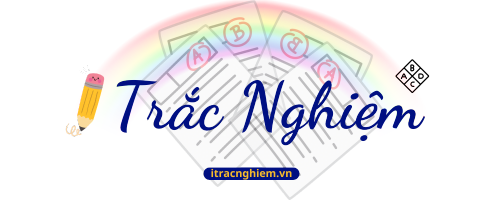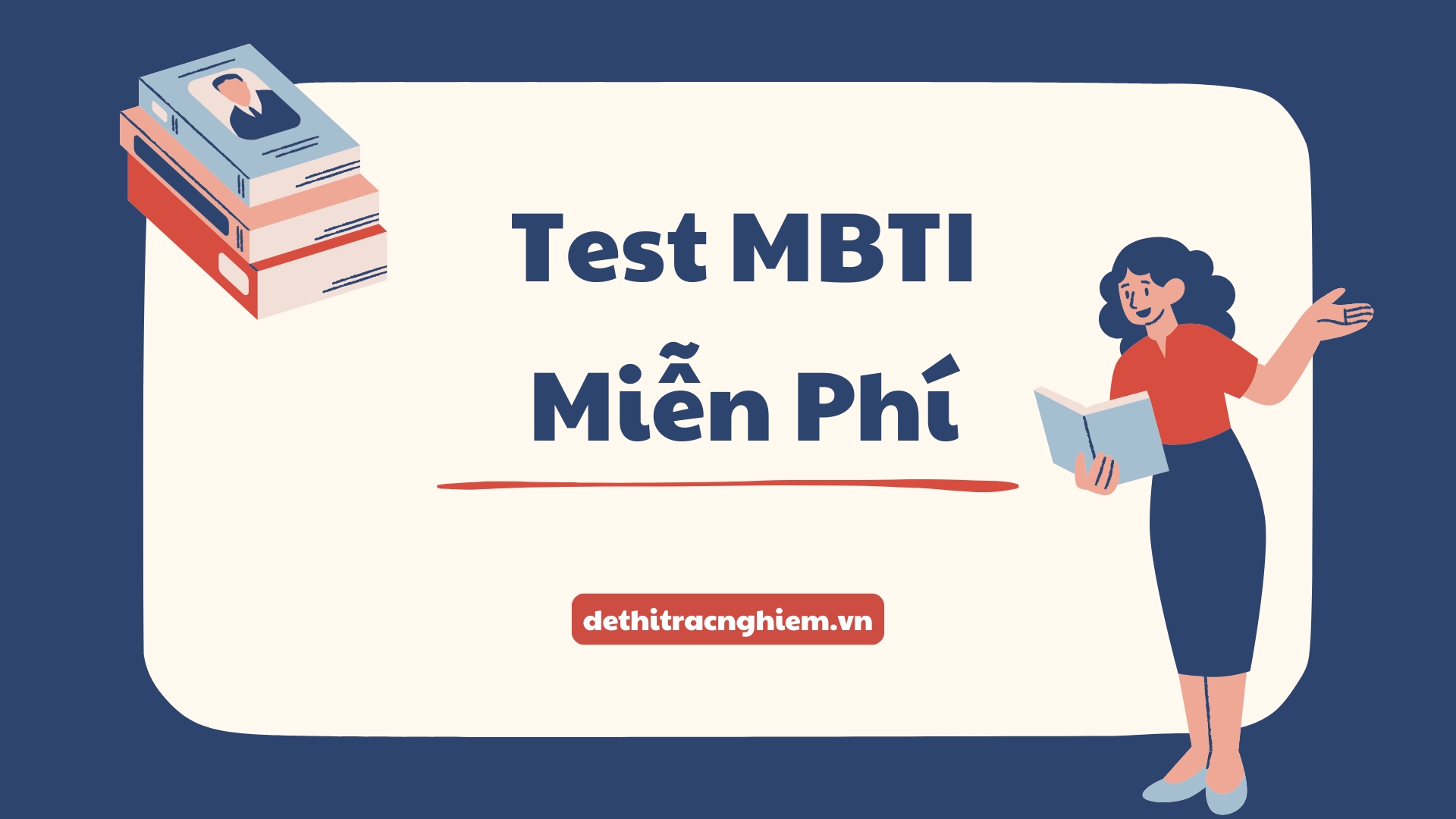Đề thi thử Đại học 2025 môn Tiếng Anh – Sở GD Yên Bái là một trong những đề tiêu biểu thuộc Tổng hợp đề thi thử môn Tiếng Anh THPT QG, nằm trong chương trình Đề thi vào Đại học. Đây là đề thi được Sở Giáo dục và Đào tạo tỉnh Yên Bái xây dựng và phát hành nhằm hỗ trợ học sinh lớp 12 ôn luyện hiệu quả, chuẩn bị cho kỳ thi tốt nghiệp THPT năm 2025.
Đề thi bao gồm đầy đủ các dạng bài quen thuộc và trọng tâm như: ngữ âm (phát âm – trọng âm), ngữ pháp – từ vựng, giao tiếp xã hội, đọc hiểu chuyên sâu, điền từ vào đoạn văn (cloze test) và viết lại câu (sentence transformation). Các câu hỏi được thiết kế theo hướng phát triển năng lực ngôn ngữ, kết hợp giữa kiểm tra kiến thức và kỹ năng tư duy ngữ cảnh – phù hợp với định hướng đổi mới của Bộ GD&ĐT.
Hãy cùng Dethitracnghiem.vn khám phá đề thi thử này và bắt tay ngay vào luyện tập để nâng cao khả năng tiếng Anh, sẵn sàng cho kỳ thi THPT Quốc gia 2025!
- Số trang: 4 trang
- Hình thức: Trắc nghiệm
- Thời gian làm bài: 50 phút (không kể thời gian phát đề)
ĐỀ THI THỬ ĐẠI HỌC MÔN TIẾNG ANH NĂM 2025 THPT SỞ GD YÊN BÁI
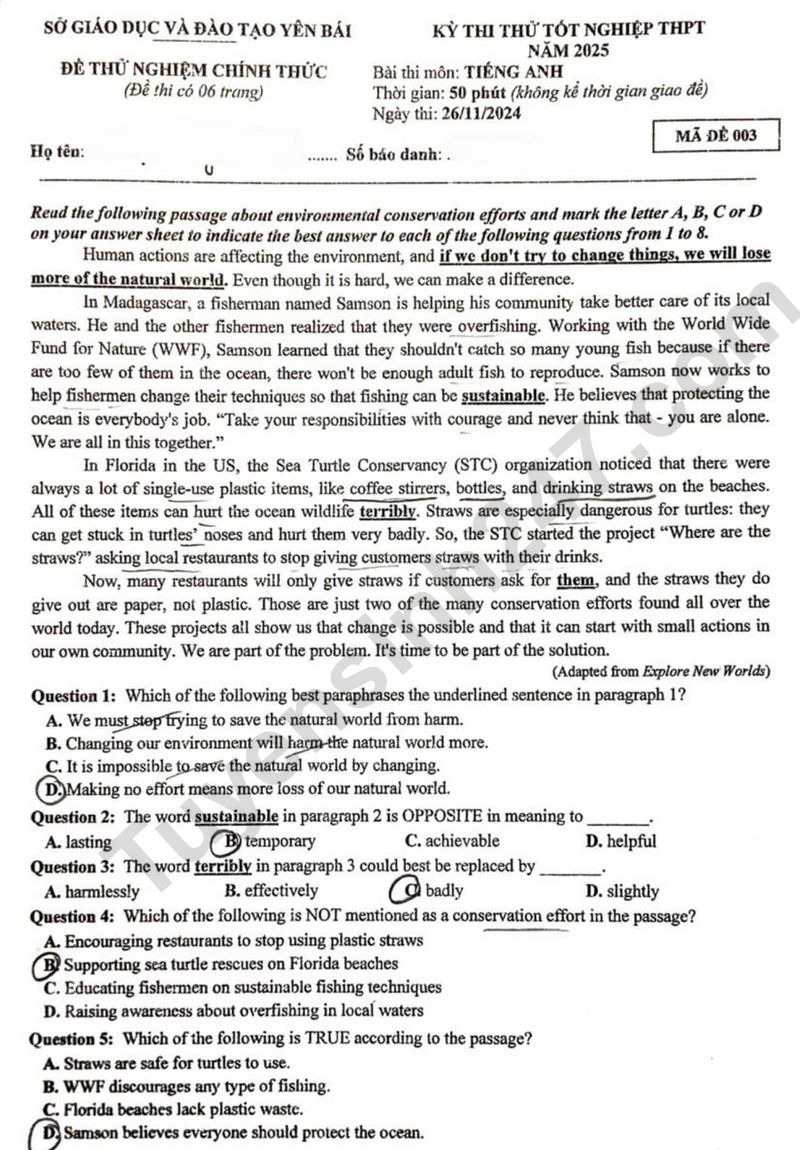
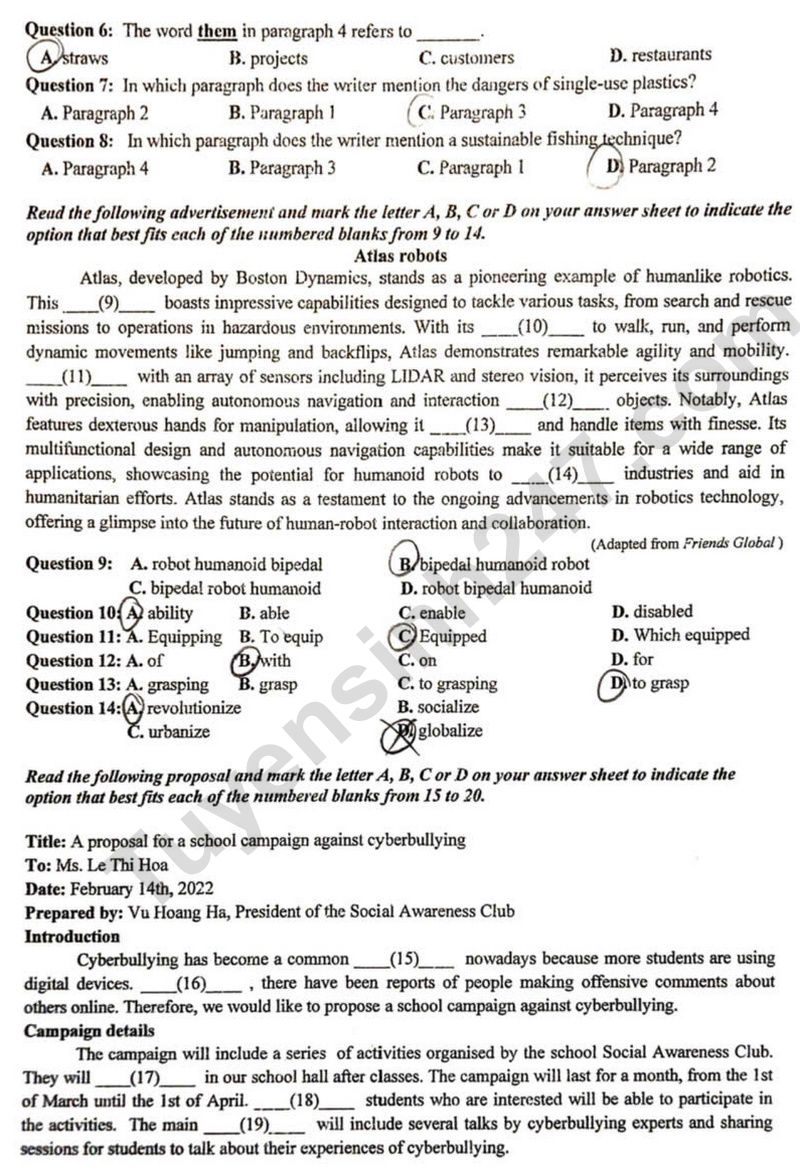
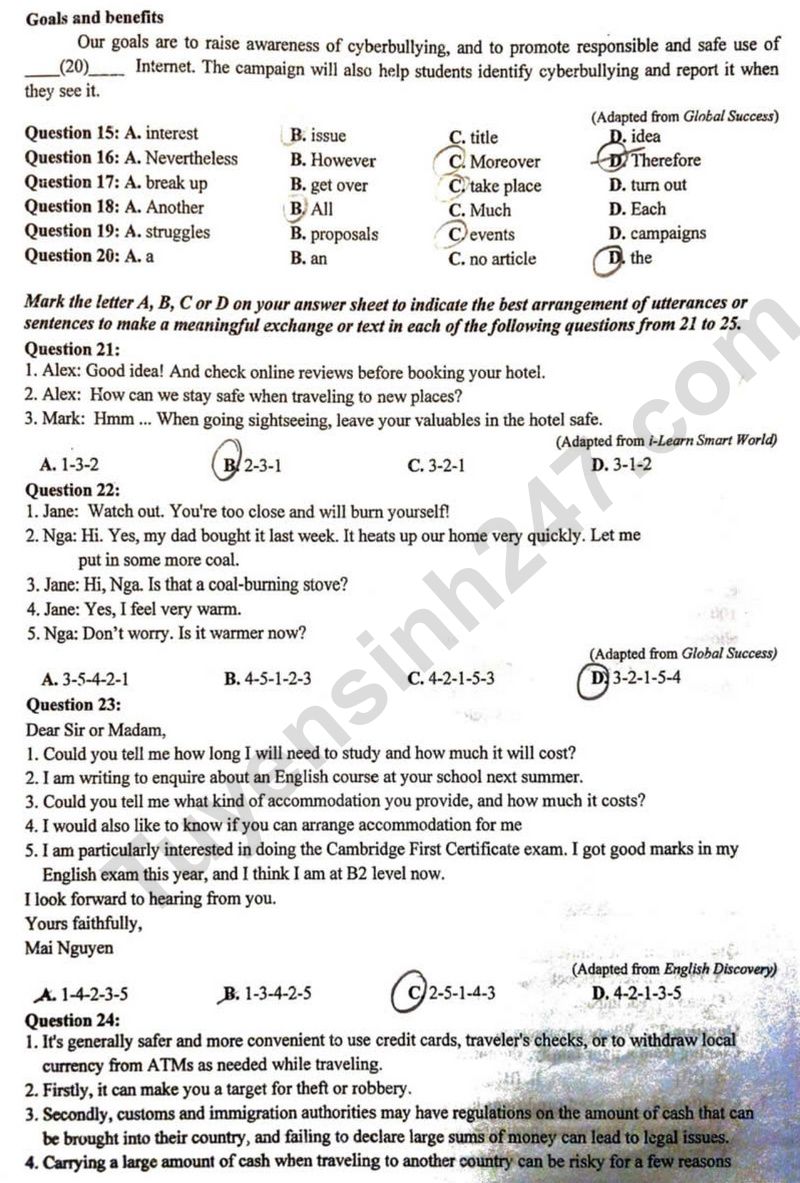
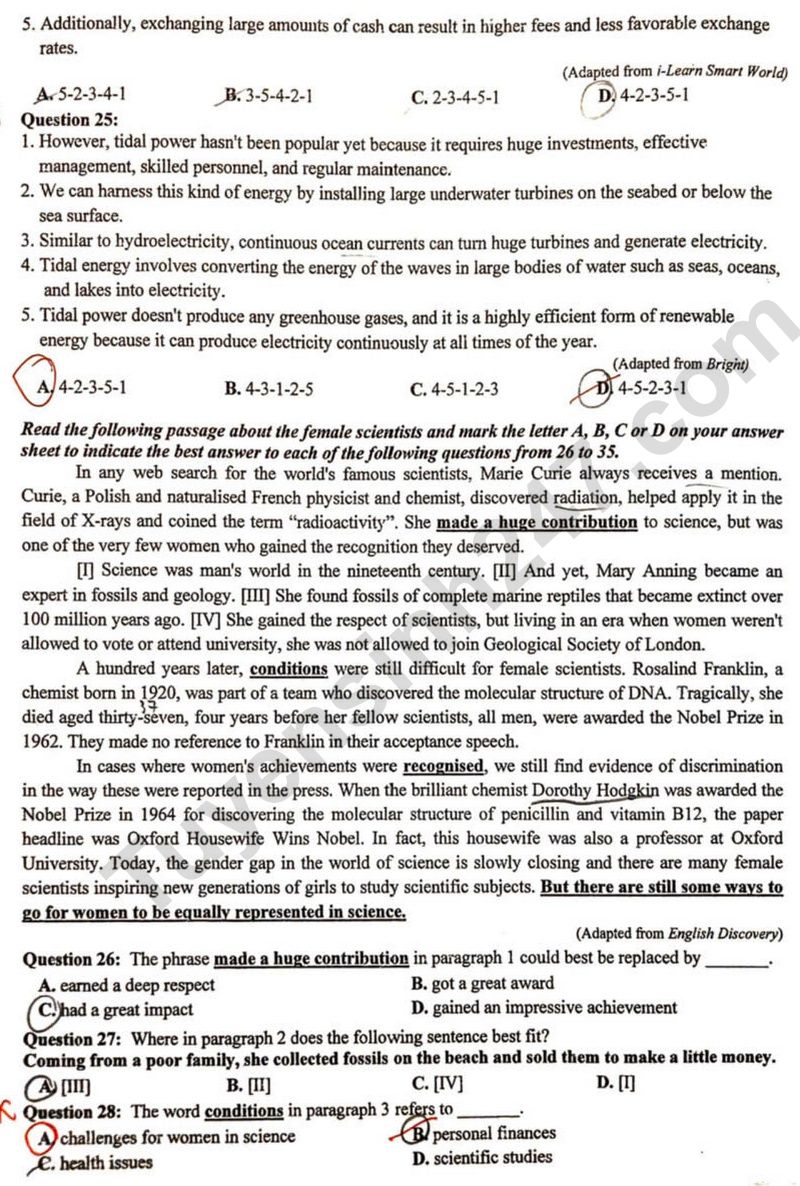
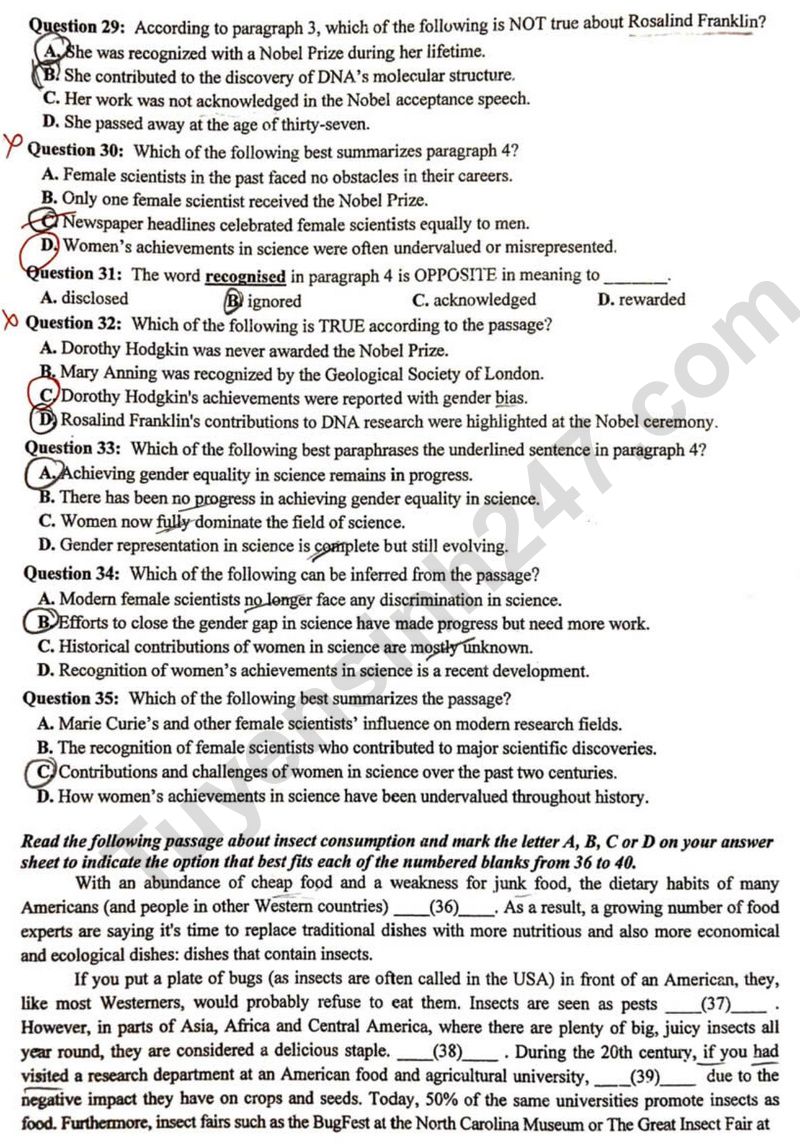

Read the following passage about environmental conservation efforts and mark the letter A, B, C or D on your answer sheet to indicate the best answer to each of the following questions from 1 to 8.
Human actions are affecting the environment, and if we don’t try to change things, we will lose more of the natural world. Even though it is hard, we can make a difference.
In Madagascar, a fisherman named Samson is helping his community take better care of its local waters. He and the other fishermen realized that they were overfishing. Working with the World Wide Fund for Nature (WWF), Samson learned that they shouldn’t catch so many young fish because if there are too few of them in the ocean, there won’t be enough adult fish to reproduce. Samson now works to help fishermen change their techniques so that fishing can be sustainable. He believes that protecting the ocean is everybody’s job. “Take your responsibilities with courage and never think that – you are alone. We are all in this together.”
In Florida in the US, the Sea Turtle Conservancy (STC) organization noticed that there were always a lot of single-use plastic items, like coffee stirrers, bottles, and drinking straws on the beaches. All of these items can hurt the ocean wildlife terribly. Straws are especially dangerous for turtles: they can get stuck in turtles’ noses and hurt them very badly. So, the STC started the project “Where are the straws?” asking local restaurants to stop giving customers straws with their drinks.
Now, many restaurants will only give straws if customers ask for them, and the straws they do give out are paper, not plastic. Those are just two of the many conservation efforts found all over the world today. These projects all show us that change is possible and that it can start with small actions in our own community. We are part of the problem. It’s time to be part of the solution.
(Adapted from Explore New Worlds)
Question 1: Which of the following best paraphrases the underlined sentence in paragraph 1?
A. We must stop trying to save the natural world from harm.
B. Changing our environment will harm the natural world more.
C. It is impossible to save the natural world by changing.
D. Making no effort means more loss of our natural world.
Question 2: The word sustainable in paragraph 2 is OPPOSITE in meaning to
A. lasting
B. temporary
C. achievable
D. helpful
Question 3: The word terribly in paragraph 3 could be best replaced by
A. harmlessly
B. effectively
C. badly
D. slightly
Question 4: Which of the following is NOT mentioned as a conservation effort in the passage?
A. Encouraging restaurants to stop using plastic straws
B. Supporting sea turtle rescues on Florida beaches
C. Educating fishermen on sustainable fishing techniques
D. Raising awareness about overfishing in local waters
Question 5: Which of the following is TRUE according to the passage?
A. Straws are safe for turtles to use.
B. WWF discourages any type of fishing.
C. Florida beaches lack plastic waste.
D. Samson believes everyone should protect the ocean.
Question 6: The word them in paragraph 4 refers to
A. straws
B. projects
C. customers
D. restaurants
Question 7: In which paragraph does the writer mention the dangers of single-use plastics?
A. Paragraph 2
B. Paragraph 1
C. Paragraph 3
D. Paragraph 4
Question 8: In which paragraph does the writer discuss the benefits of ocean conservation?
A. Paragraph 4
B. Paragraph 3
C. Paragraph 1
D. Paragraph 2
Mark the letter A, B, C, or D on your answer sheet to indicate the correct option that best fits each of the numbered blanks from 9 to 14.
Atlas robots
Atlas, developed by Boston Dynamics, stands as a pioneering example of humanlike robotics. This (9) ______ boasts impressive capabilities designed to tackle various tasks, from search and rescue missions to operations in hazardous environments. Atlas demonstrates remarkable agility and mobility. (10) ______ to walk, run, and perform dynamic movements like jumping and backflips, Atlas demonstrates remarkable agility and mobility. (11) ______ with an array of sensors including LiDAR and stereo vision, it perceives its surroundings with precision, enabling autonomous navigation and interaction (12) ______ objects. Notably, Atlas features dexterous hands for manipulation, allowing it (13) ______ and handle items with finesse. Its multifunctional design and autonomous navigation capabilities make it suitable for a wide range of applications, showcasing the potential for humanoid robots to (14) ______ industries and aid in humanitarian efforts.
(Adapted from Friends Global )
Question 9:
A. robot humanoid bipedal
B. bipedal humanoid robot
C. bipedal robot humanoid
D. robot bipedal humanoid
Question 10:
A. ability
B. able
C. enabled
D. disabled
Question 11:
A. Equip
B. to equip
C. Equipped
D. Which equipped
Question 12:
A. of
B. with
C. on
D. for
Question 13:
A. grasping
B. grasp
C. to grasping
D. to grasp
Question 14:
A. revolutionize
B. globalize
C. socialize
D. urbanize
Read the following proposal and mark the letter A, B, C or D on your answer sheet to indicate the option that best fits each of the numbered blanks from 15 to 20.
Title: A proposal for a school campaign against cyberbullying
To: Ms. Le Thi Hoa
Date: February 14th, 2022
Prepared by: Vu Hoang Ha, President of the Social Awareness Club
Introduction
Cyberbullying has become a common (15) ______ nowadays because more students are using digital devices. (16) ______, there have been reports of people making offensive comments about others online. Therefore, we would like to propose a school campaign against cyberbullying.
Campaign details
The campaign will include a series of activities organised by the school Social Awareness Club. They will (17) ______ in our school hall after classes. From March 1st until the 1st of April. (18) ______, students who are interested will be able to participate in the activities. The main (19) ______ will include several talks by cyberbullying experts and sharing sessions for students to talk about their experiences of cyberbullying.
Goals and benefits
Our goals are to raise awareness of cyberbullying, and to promote responsible and safe use of (20) ______. Internet. The campaign will also help students identify cyberbullying and report it when they see it.
Question 15:
A. interest
B. issue
C. title
D. idea
Question 16:
A. Nevertheless
B. However
C. Moreover
D. Therefore
Question 17:
A. break up
B. get over
C. take place
D. turn out
Question 18:
A. Another
B. All
C. Much
D. Each
Question 19:
A. proposals
B. events
C. campaigns
D. The
Question 20:
A. a
B. an
C. article
D. the
Mark the letter A, B, C or D on your answer sheet to indicate the best arrangement of sentences or utterances to make a meaningful exchange in each of the following questions from 21 to 25.
Question 21:
1. Alex: Good idea! And check online reviews before booking your hotel.
2. Alex: How can we stay safe when traveling to new places?
3. Mark: Hmm… When going sightseeing, leave your valuables in the hotel safe.
A. 1-3-2
B. 2-3-1
C. 3-2-1
D. 3-1-2
Question 22:
1. Jane: Watch out. You’re too close and will burn yourself!
2. Nga: Hi. Yes, my dad bought it last week. It heats up our home very quickly. Let me put in some more coal.
3. Jane: Hi, Nga. Is that a coal-burning stove?
4. Jane: Yes, I feel very warm.
5. Nga: Don’t worry. Is it warmer now?
A. 3-5-4-2-1
B. 4-5-1-2-3
C. 4-2-1-5-3
D. 3-2-1-5-4
Question 23:
Dear Sir or Madam,
1. Could you tell me how long I will need to study and how much it will cost?
2. I am writing to enquire about an English course at your school next summer.
3. Could you tell me what kind of accommodation you provide, and how much it costs?
4. I would also like to know if you can arrange accommodation for me
5. I am particularly interested in doing the Cambridge First Certificate exam. I got good marks in my English exam this year, and I think I am at B2 level now.
Yours faithfully,
Mai Nguyen
A. 1-4-2-3-5
B. 1-3-4-2-5
C. 2-5-1-4-3
D. 4-2-1-3-5
Question 24:
1. It’s generally safer and more convenient to use credit cards, traveler’s checks, or to withdraw local currency from ATMs as needed while traveling.
2. Firstly, it can make you a target for theft or robbery.
3. Secondly, customs and immigration authorities may have regulations on the amount of cash that can be brought into their country, and failing to declare large sums of money can lead to legal issues.
4. Carrying a large amount of cash when traveling to another country can be risky for a few reasons.
5. Additionally, exchanging large amounts of cash can result in higher fees and less favorable exchange rates.
A. 5-2-3-4-1
B. 3-5-4-2-1
C. 2-3-4-5-1
D. 4-2-3-5-1
Question 25:
1. However, tidal power hasn’t been popular yet because it requires huge investments, effective management, skilled personnel, and regular maintenance.
2. We can harness this kind of energy by installing large underwater turbines on the seabed or below the sea surface.
3. Similar to hydroelectricity, continuous ocean currents can turn huge turbines and generate electricity.
4. Tidal energy involves converting the energy of the waves in large bodies of water such as seas, oceans, and lakes into electricity.
5. Tidal power doesn’t produce any greenhouse gases, and it is a highly efficient form of renewable energy because it can produce electricity continuously at all times of the year.
A. 4-2-3-5-1
B. 4-3-1-2-5
C. 4-5-1-2-3
D. 4-5-2-3-1
Read the following passage about the female scientists and mark the letter A, B, C or D on your answer sheet to indicate the best answer to each of the following questions from 26 to 35.
In any web search for the world’s famous scientists, Marie Curie always receives a mention. Curie, a Polish and naturalised French physicist and chemist, discovered radiation, helped apply it in the field of X-rays and coined the term “radioactivity”. She made a huge contribution to science, but was one of the very few women who gained the recognition they deserved.
[I] Science was man’s world in the nineteenth century. [II] And yet, Mary Anning became an expert in fossils and geology. [III] She found fossils of complete marine reptiles that became extinct over 100 million years ago. [IV] She gained the respect of scientists, but living in an era when women weren’t allowed to vote or attend university, she was not allowed to join Geological Society of London.
A hundred years later, conditions were still difficult for female scientists. Rosalind Franklin, a chemist born in 1920, was part of a team who discovered the molecular structure of DNA. Tragically, she died aged thirty-seven, four years before her fellow scientists, all men, were awarded the Nobel Prize in 1962. They made no reference to Franklin in their acceptance speech.
In cases where women’s achievements were recognised, we still find evidence of discrimination in the way these were reported by the press. When the brilliant chemist Dorothy Hodgkin was awarded the Nobel Prize in 1964 for discovering the molecular structure of penicillin and Vitamin B12, the paper headline was ‘Oxford Housewife Wins Nobel’. In fact, this housewife was also a professor at Oxford University. Today, the gender gap in the world of science is slowly closing and there are many female scientists inspiring new generations of girls to study scientific subjects. But there are still some ways to go for women to be equally represented in science.
Question 26: The phrase made a huge contribution in paragraph 1 could be best replaced by ______.
A. earned a deep respect
B. got a great award
C. gained an impressive achievement
D. had a great impact
Question 27: In which paragraph 2 does the following sentence fit best?
Coming from a poor family, she collected fossils in the beach and sold them to make a little money.
A. [III]
B. [II]
C. [IV]
D. [I]
Question 28: The word conditions in paragraph 3 refers to ______.
A. challenges for women in science
B. personal finances
C. health issues
D. scientific studies
Question 29: According to paragraph 3, which of the following is NOT true about Rosalind Franklin?
A. She was recognized with a Nobel Prize during her lifetime.
B. She contributed to the discovery of DNA’s molecular structure.
C. Her work was not acknowledged in the Nobel acceptance speech.
D. She passed away at the age of thirty-seven.
Question 30: Which of the following best summarizes passage?
A. Female scientists in the past faced no obstacles in their careers.
B. Only one female scientist received the Nobel Prize.
C. Newspaper headlines celebrated female scientists equally to men.
D. Women’s achievements in science were often undervalued or misrepresented.
Question 31: The word recognised in paragraph 4 is OPPOSITE in meaning to ______.
A. disclosed
B. ignored
C. acknowledged
D. rewarded
Question 32: Which of the following is TRUE according to the passage?
A. Dorothy Hodgkin was never awarded the Nobel Prize.
B. Mary Anning was recognized by the Geological Society of London.
C. Dorothy Hodgkin’s achievements were reported with gender bias.
D. Rosalind Franklin’s contributions to DNA research were highlighted at the Nobel ceremony.
Question 33: Which of the following best paraphrases the underlined sentence in paragraph 4?
A. Achieving gender equality in science remains in progress.
B. There has been no progress in achieving gender equality in science.
C. Women now fully dominate the field of science.
D. Gender representation in science is complete but still evolving.
Question 34: Which of the following can be inferred from the passage?
A. Modern female scientists no longer face any discrimination in science.
B. Efforts to close the gender gap in science have made progress but need more work.
C. Historical contributions of women in science are mostly unknown.
D. Recognition of women’s achievements in science is a recent development.
Question 35: Which of the following best summarizes the passage?
A. Marie Curie’s and other female scientists’ influence on modern research fields.
B. The recognition of female scientists who contributed to major scientific discoveries.
C. Contributions and challenges of women in science over the past two centuries.
D. How women’s achievements in science have been undervalued throughout history.
Read the following passage about insect consumption and mark the letter A, B, C or D on your answer sheet to indicate the option that best fits each of the numbered blanks from 36 to 40.
With an abundance of cheap food and a weakness for junk food, the dietary habits of many Americans (and people in other Western countries). (36) ______ As a result, a growing number of food experts are saying it’s time to replace traditional dishes with more nutritious and also more economical and ecological dishes: dishes that contain insects.
If you put a plate of bugs (as insects are often called in the USA) in front of an American, they, like most Westerners, would probably refuse to eat them. Insects are seen as pests (37) ______ damages not only food crops but also eaten delicacies. However, in parts of Asia, Africa and Central America, where there are plenty of big, juicy insects all year round, they are considered a delicious staple. (38) ______, During the 20th century, if you had visited a research department at an American food and agricultural university, (39) ______ due to the negative impact they have on crops and seeds. Today, 50% of the same universities promote insects as food. Furthermore, insect fairs such as the BugFest at the North Carolina Museum or The Great Insect Fair at Penn State University explain that grasshoppers, moths and their cousins are an excellent source of nutrients like protein, minerals and vitamins. (40) ______.
Question 36:
A. have led to an obesity epidemic
B. by which obesity trend is affected
C. which obesity trend is affected
D. that resulted in more people with obesity
Question 37:
A. regards as delicacies and food crops eaten everywhere
B. by which food crops as well as consumed delicacies
C. damages not only food crops but also eaten delicacies
D. that destroy food crops rather than delicacies to be eaten
Question 38:
A. Insect-based meals are seen to be challenges to their promoters in the same way as to Americans.
B. The challenge for the promoters of insect-based meals is to make Americans see them in the same way.
C. The promoters of insect-based meals challenge Americans to make and see them in the same way.
D. Intending to make insect-based meals in the same way, challenges are created for American promoters.
Question 39:
A. they would hear about how you were making an effort to reduce insect numbers
B. they were trying to reduce insect numbers and you would try to hear about them
C. you heard about how insect numbers were going to be controlled by them
D. you would have heard about how they were trying to reduce insect numbers
Question 40:
A. The fairs also offer the adventurous visitors ‘bug banquets’, which serve mouth-watering insect dishes.
B. More adventurous people visit the fairs…
C. Serving mouth-watering insect dishes…
D. Without ‘bug banquets’…
Mục đích tổ chức kỳ thi Đại học năm 2025 là gì?
Căn cứ theo quy chế hiện hành của Bộ Giáo dục và Đào tạo và các văn bản hướng dẫn tổ chức kỳ thi Đại học năm 2025, mục đích của kỳ thi là:
– Đánh giá kết quả học tập của học sinh sau 12 năm học theo yêu cầu của chương trình giáo dục phổ thông.
– Lấy kết quả thi để xét công nhận tốt nghiệp trung học phổ thông và làm căn cứ tuyển sinh đại học, cao đẳng.
– Góp phần đánh giá chất lượng giáo dục của địa phương và cả nước, làm cơ sở điều chỉnh nội dung, phương pháp dạy học trong nhà trường.
Thí sinh thi Đại học năm 2025 có bắt buộc thi môn Tiếng Anh không?
Theo quy định hiện hành của Bộ Giáo dục và Đào tạo và hướng dẫn tổ chức kỳ thi tốt nghiệp Đại học năm 2025, thí sinh dự thi phải thực hiện như sau:
– Thi 3 môn bắt buộc: Toán, Ngữ văn và Ngoại ngữ.
– Ngoài ra, thí sinh phải chọn một trong hai bài thi tổ hợp: Khoa học Tự nhiên (gồm các môn Vật lí, Hóa học, Sinh học) hoặc Khoa học Xã hội (gồm các môn Lịch sử, Địa lí, Giáo dục công dân – dành cho học sinh học chương trình giáo dục phổ thông).
Trong số các môn thi, Tiếng Anh là một trong ba môn thuộc bài thi Ngoại ngữ bắt buộc, thí sinh phải thi môn Tiếng Anh như một môn bắt buộc, không phụ thuộc vào lựa chọn bài thi tổ hợp hay mục đích xét tuyển đại học.
Như vậy, kỳ thi Đại học năm 2025 bắt buộc thí sinh phải thi môn Tiếng Anh.
